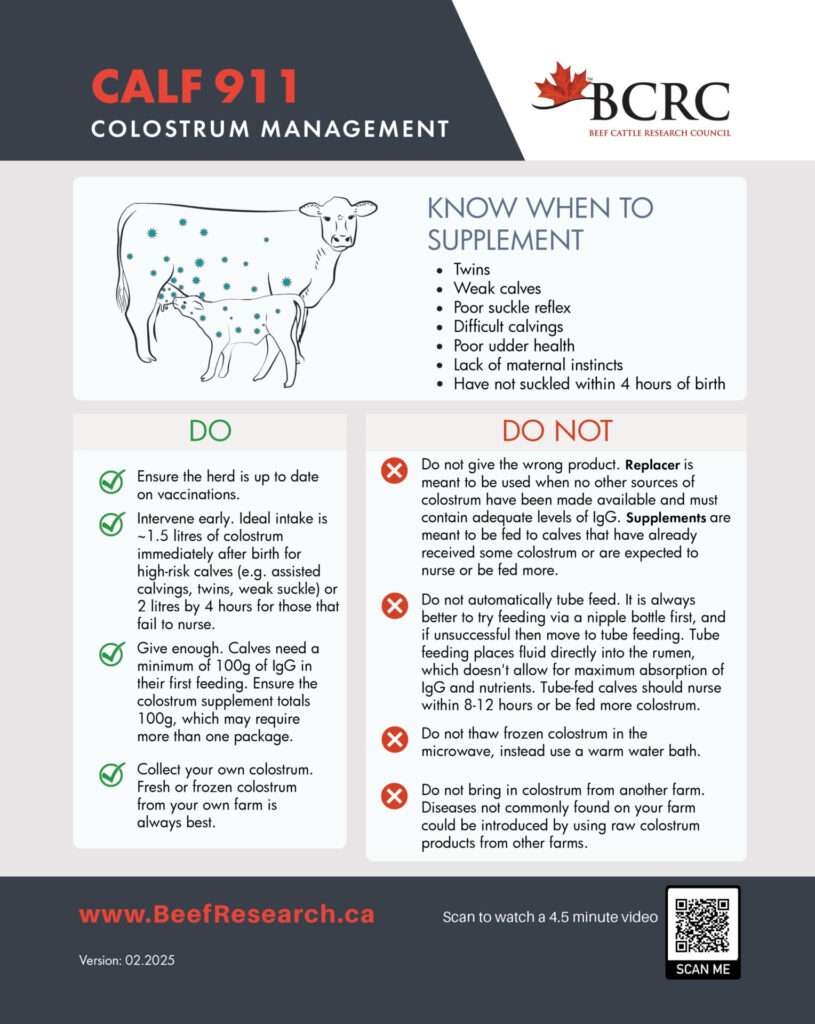Calf 911 - How to Manage Colostrum to Allow Newborn Calves to Thrive ▶️
Ensuring newborn calves consume colostrum is one of the most important management strategies cow-calf operations can implement to promote healthy calves. Colostrum provides essential antibodies (like Immunoglobulin G or IgG) to a calf with virtually no immune system. Colostrum also contains fats, vitamins, proteins and other immune cells essential to provide the calf energy, warmth and the local immunity it requires to thrive in the first few days of life. This initial immunity will protect against calfhood diseases such as scours, navel abscesses, septic arthritis and pneumonia.
Calves that are born unassisted and uncompromised will typically stand and nurse from their mothers within one to two hours after birth. However, calves that experience a difficult or prolonged birth, have a swollen tongue, experience hypothermia or are a twin may be less vigorous and unable to stand and nurse during that critical period. A cow with a large udder, poor udder suspension and/or large teats may also limit a calf’s ability to receive adequate colostrum.
It is crucial for producers to observe newborn calves to make sure they have received colostrum and to intervene if necessary. Look closely to see if any of the cow’s teats have been suckled, feel if the calf’s belly is full and check the hooves to see if the rubbery capsule has been worn off to indicate standing. Checking a calf’s suckle reflex by sticking your fingers in the calf’s mouth is also a simple indicator to demonstrate whether the suckle reflex is weak and the calf needs to be supplemented with colostrum.
Considerations when feeding a calf colostrum:
- Early intervention is key. Antibody absorption drops after six hours following birth, and by hour 12, the gut capacity to absorb antibodies drops by half. After 24 hours, the calf’s gut will be “closed” and no longer allows passing of antibodies through the gut lining.
- Beef calves should receive at least two litres (or 8.5 cups; 0.5 gallons) of colostrum within the first two hours of being born. If feeding colostrum, ensure it is warmed to 38°C (100°F).
- Some colostrum is better than none. If you think a calf has not received colostrum and you are within the 24-hour window, provide it. After 24 hours, any colostrum that is fed will not be absorbed and is a waste of good quality IgG.
- Always attempt feeding colostrum by bottle first, which allows colostrum to enter the abomasum where antibody absorption is maximized. In contrast, tube feeding first places colostrum in the rumen, where antibody absorption is limited, and colostrum only reaches the abomasum once the rumen overflows.
- The BEST SOURCE OF COLOSTRUM is from your own herd. Colostrum can be milked from the newly calved cow or collected from another cow on-farm and frozen and stored for up to one year. This ensures the colostrum received provides immunity to the calf from diseases that are specific to that farm and the calf’s environment while maintaining a closed herd.
- DON’T feed calves colostrum from other farms because of the risk of disease transmission like E. coli, Salmonella spp., Mycoplasma bovis and MAP (Mycobacterium avium paratuberculosis, the precursor to Johne’s disease).
- Store by freezing colostrum in a large Ziplock bag, laying it flat. Be sure to label the bags and use within a year of storage.
- NEVER thaw colostrum in the microwave because this will destroy antibodies. Instead, place the frozen Ziplock bag in a bucket of warm water and allow to thaw and warm slowly.
- Colostrum replacer or supplement products are sufficient if other options are not available, but remember that products labeled as a “Colostrum Supplement” DO NOT provide calves with enough antibodies to be relied on alone. “Supplement” products may provide a boost to calves who have had SOME colostrum but need more energy, fat and protein supplement with a little bit of IgG. For calves that have had no other colostrum, use a product labeled as “Colostrum Replacement.” Regardless of the source, colostrum should contain a minimum of 100g IgG up to 300g IgG. Very few colostrum replacer products provide 100g, so read the label carefully.
- DON’T feed beef calves colostrum from dairy animals, as antibody concentration in dairy colostrum is typically lower than in beef colostrum.
Properly managing colostrum on your operation can minimize the risk of disease and death and increase growth in pre-weaned calves. Ensuring each calf has received adequate colostrum will provide calves with the best start to a healthy and productive life.
For more information, visit our Calving and Calf Management webpage.
This post is part of our #Calf911 series. Click to learn more and see more videos.
Click here to subscribe to the BCRC Blog and receive email notifications when new content is posted.
The sharing or reprinting of BCRC Blog articles is welcome and encouraged. Please provide acknowledgement to the Beef Cattle Research Council, list the website address, www.BeefResearch.ca, and let us know you chose to share the article by emailing us at [email protected].
We welcome your questions, comments and suggestions. Contact us directly or generate public discussion by posting your thoughts below.
